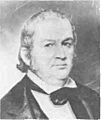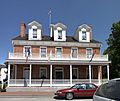Ste. Genevieve, Missouri facts for kids
Quick facts for kids
Ste. Genevieve, Missouri
|
|
|---|---|
|
City
|
|

Maison Bequette-Ribault,
c. 1805; privately owned |
|
| Nickname(s):
"The Mother City of the West"
|
|

Location of Ste. Genevieve, Missouri
|
|

U.S. Census Map
|
|
| Country | United States |
| State | Missouri |
| County | Ste. Genevieve |
| Township | Ste. Genevieve |
| Incorporated | 1805 |
| Named for | Saint Genevieve |
| Area | |
| • Total | 3.90 sq mi (10.11 km2) |
| • Land | 3.90 sq mi (10.10 km2) |
| • Water | 0.00 sq mi (0.01 km2) |
| Elevation | 427 ft (130 m) |
| Population
(2020)
|
|
| • Total | 4,999 |
| • Density | 1,282.12/sq mi (495.00/km2) |
| Time zone | UTC-6 (Central (CST)) |
| • Summer (DST) | UTC-5 (CDT) |
| Zip code |
63670
|
| Area code(s) | 573 |
| FIPS code | 29-64180 |
| GNIS feature ID | 2396523 |
| Website | http://www.stegenevieve.org/ |
Ste. Genevieve is a city in Ste. Genevieve Township, Missouri. It is the county seat of Ste. Genevieve County. In 2020, about 4,999 people lived there.
French-Canadian settlers founded Ste. Genevieve around 1735. It was the first organized European settlement west of the Mississippi River in what is now Missouri. Today, it is home to Ste. Genevieve National Historical Park, which is part of the National Park Service.
Contents
History of Ste. Genevieve
Ste. Genevieve is the oldest permanent European settlement in Missouri. It was founded around 1740 by settlers from French communities east of the Mississippi River. The city is named after Saint Genevieve, who is the patron saint of Paris, France. Many of the founding families had lived in the Illinois Country for two or three generations.
This area was once known as New France, or the Upper Louisiana territory. Historians believe the town was founded around 1750. People moved here from east of the river because they needed more land for farming. Also, better relations with Native American tribes like the Osage made it safer to settle.
Before the French settlers arrived, different indigenous peoples lived in this region for over a thousand years. The most famous were the Mississippian culture. They built large earth mounds, like those at Cahokia. They also had a large trading network along the Mississippi-Ohio rivers.
When Europeans settled, no Native American tribe lived very close on the west bank. Maps from 1755 showed Kaskaskia natives on the east side of the river. But there were no Indian villages within 100 miles of Ste. Genevieve on the west side. Osage hunting and war parties did enter the area from the north and west.
Ste. Genevieve was one of three French-Canadian settlements in this part of the Mississippi Valley. Fort de Chartres was about five miles northeast, and Kaskaskia was about five miles southeast. Other early French towns included Prairie du Rocher and Cahokia, Illinois.
Changes in Control: French, Spanish, and American Rule
After losing the French and Indian War, France secretly gave the west bank of the Mississippi River to Spain in 1762. This area became Louisiana (New Spain). The Spanish moved the capital of Upper Louisiana to St. Louis. They allowed French-speaking officials to mostly run things. Even though Spain controlled Ste. Genevieve for over 40 years, it kept its French language, customs, and culture.
In 1763, France gave the land east of the Mississippi to Great Britain. This was part of the Treaty of Paris (1763). Many French-speaking people moved west to avoid British rule. They came to Ste. Genevieve after King George III made a rule in 1763. This rule turned most of the captured French land into an Indian reserve. Settlers were told to leave or get British permission to stay.
During the 1770s, Little Osage and Missouri tribes sometimes raided Ste. Genevieve. They would steal horses from settlers. However, the fur trade and marriages between French-Canadian men and Native American women created many connections. In the 1780s, some Shawnee and Lenape (Delaware) tribes moved west of the Mississippi. They settled south of Ste. Genevieve. The Peoria also moved nearby and had a peaceful relationship.
In the 1790s, the Big Osage became more aggressive. They raided the settlement and attacked the Peoria and Shawnee. Spanish leaders wanted to fight the Big Osage. But there were not enough French settlers to form a militia. In 1794, the Spanish governor made Pierre Chouteau and Auguste Chouteau of St. Louis the only ones allowed to trade with the Big Osage. This helped improve relations.
Old Ste. Genevieve: A Farming Town
After a big flood in 1785, the town moved from its first spot by the Mississippi River. It moved two miles north and about half a mile inland. The town continued to grow as a farming community. They grew mostly wheat, corn, and tobacco. Most families were small farmers. They grew enough grain to send many tons of flour to New Orleans each year. This was important for the southern colonies, which could not grow enough grain. In 1807, Ste. Genevieve was called "the most wealthy village in Louisiana."
Unique Architecture
The oldest buildings in Ste. Genevieve are called "French Creole colonial." They were built when Spain ruled the area in the late 1700s. The most special buildings were made with "vertical wooden post" walls. The posts were either dug into the ground (poteaux en terre) or set on a stone foundation (poteaux sur solle). This was different from the log cabin style used by other American settlers.
The poteaux en terre houses have walls made of upright wooden posts. These posts are partly set into the dirt. The floors are supported by separate stone pillars. These buildings were easily damaged by floods, termites, and rot. Ste. Genevieve has three of the five surviving poteaux en terre houses in the United States.
Most of the oldest buildings are poteaux sur solle ("posts-on-a-sill"). One of the oldest is the Louis Bolduc House, built in 1792. It is a National Historic Landmark. Other important buildings include the 1806 La Maison de Guibourd Historic House, the 1818 Felix Vallé House State Historic Site, and the 1792 Beauvais-Amoureux House.
French Culture and Traditions
For many years, Ste. Genevieve was mainly a farming town. The habitants (residents) grew wheat, corn, and tobacco. They produced more wheat than people in St. Louis. Their grain was sent south to help the French community in New Orleans.
The town followed old traditions. Most people lived in town lots. They farmed land in a large common field. This land was divided into long, narrow strips. Each settler had a strip that went from the river to the hills. Only the outside of the Grand Champ (Big Field) was fenced. Farmers used the same tools and plows as in 18th-century France. They used oxen to pull their plows.
After the Louisiana Purchase in 1804, more people moved to Ste. Genevieve. These included Anglo-Americans and German immigrants. The town became more focused on trade. But the villagers kept many of their French customs. The Sisters of St. Joseph, a French teaching order, started a convent and a Catholic school. The current Ste. Genevieve Catholic Church was built in 1876. It looks like Gothic churches in France.
Ste. Genevieve still celebrates its French heritage with many events. These include La Guiannée (a Christmas celebration), French Fest, and Jour de Fête. Tourism based on its history is important for the town's economy.
The "French Connection" Ferry
The Ste. Genevieve-Modoc Ferry crosses the Mississippi River to Illinois. It is called the "French Connection." This name refers to the ferry's link to other French colonial sites nearby. These include Fort de Chartres and Fort Kaskasia State Historic Sites. The ferry runs every day, unless the river is flooding. It can carry cars, people walking, and people with bicycles.
Geography
Ste. Genevieve is on the west bank of the Mississippi River. It is near the Illinois state line. Major roads like Interstate 55, U.S. Route 61, and Missouri Route 32 pass through it. The city is about 46 miles (74 km) south of St. Louis.
The city covers about 4.11 square miles (10.64 km2). Most of this area is land, with a small amount of water. Ste. Genevieve has a humid subtropical climate. This means it has hot, humid summers and mild winters. Average monthly temperatures range from 32.4°F (0.2°C) in January to 78.6°F (25.9°C) in July.
Nearby Communities
Population Data
| Historical population | |||
|---|---|---|---|
| Census | Pop. | %± | |
| 1850 | 718 | — | |
| 1860 | 1,277 | 77.9% | |
| 1870 | 1,521 | 19.1% | |
| 1880 | 1,422 | −6.5% | |
| 1890 | 1,586 | 11.5% | |
| 1900 | 1,707 | 7.6% | |
| 1910 | 1,967 | 15.2% | |
| 1920 | 2,046 | 4.0% | |
| 1930 | 2,662 | 30.1% | |
| 1940 | 2,787 | 4.7% | |
| 1950 | 3,992 | 43.2% | |
| 1960 | 4,443 | 11.3% | |
| 1970 | 4,468 | 0.6% | |
| 1980 | 4,481 | 0.3% | |
| 1990 | 4,411 | −1.6% | |
| 2000 | 4,476 | 1.5% | |
| 2010 | 4,410 | −1.5% | |
| 2020 | 4,999 | 13.4% | |
| U.S. Decennial Census 2020 | |||
2010 Census Information
In 2010, Ste. Genevieve had 4,410 people living in 1,824 households. About 27.2% of households had children under 18. About 43.6% were married couples. The average household had 2.28 people.
The average age in the city was 43 years old. About 21.8% of residents were under 18. About 20.5% were 65 or older. The population was 48.4% male and 51.6% female.
Education
The Ste. Genevieve R-II School District manages public schools in Ste. Genevieve. The city also has a public library, called the Ste. Genevieve Branch Library.
Media
The Ste. Genevieve Herald is a weekly newspaper. It has served Ste. Genevieve County since May 1882.
Notable People from Ste. Genevieve
- Steve Bieser - Head Baseball Coach at the University of Missouri
- Lewis Vital Bogy - U.S. Senator from Missouri
- Henry Brackenridge - lived here as a boy and wrote about the town
- Firmin Rene Desloge - important businessman, part of the Desloge Family in America
- Augustus Caesar Dodge - US Senator from Iowa
- Henry Dodge - US Senator from Wisconsin
- Laurent Durocher - member of the Michigan Senate
- Pierre Gibault - 18th-century French Jesuit priest and missionary
- Lewis Fields Linn - U.S. Senator from Missouri
- William Pope McArthur - American naval officer and mapmaker
- Robert Moore - Oregon pioneer and founder of Linn City, Oregon
- Charles Nerinckx - founder of the Sisters of Loretto religious order
- Nathaniel Pope - US Representative from the Illinois Territory
- Philippe-François de Rastel de Rocheblave - French military and political figure
- Prospect K. Robbins - surveyor who established the Fifth Principal Meridian
- Frank Rolfe - real estate investor; owner of the Ste. Genevieve Academy
- Jean Ferdinand Rozier - 19th-century businessman and partner of John James Audubon
- François Vallé - 18th-century pioneer, mine owner, and land-holder
- John Hardeman Walker - US Congressman
- Matthew E. Ziegler - American Artist
Gallery of Notable People
-
Pierre Gibault
(1737–1802),
Jesuit priest -
John James Audubon
(1785–1851),
French-American ornithologist, naturalist, hunter, and painter -
William Pope McArthur
(1814–1850),
first mapmaker of U.S. Pacific Coast
Historical Flags of Ste. Genevieve
-
Flag of New France
to 1763 -
Flag of New Spain
1763–1803 -
15 star-15 stripe US flag
1804–1818 -
Flag of Missouri
from 1913
Sister Cities
Ste. Genevieve has two sister cities:
Galleries
Recent Photos
Archival Photos
See also
 In Spanish: Ste. Genevieve (Misuri) para niños
In Spanish: Ste. Genevieve (Misuri) para niños







































